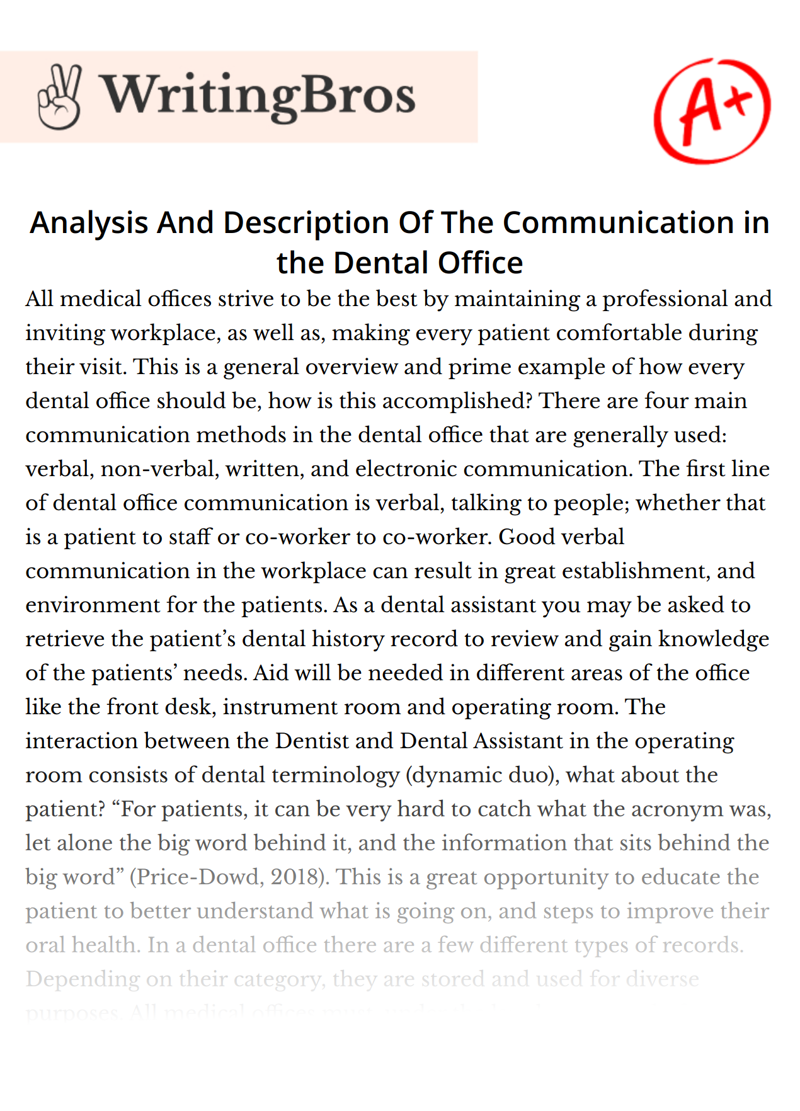Analysis And Description Of The Communication in the Dental Office

All medical offices strive to be the best by maintaining a professional and inviting workplace, as well as, making every patient comfortable during their visit. This is a general overview and prime example of how every dental office should be, how is this accomplished? There are four main communication methods in the dental office that are generally used: verbal, non-verbal, written, and electronic communication.
The first line of dental office communication is verbal, talking to people; whether that is a patient to staff or co-worker to co-worker. Good verbal communication in the workplace can result in great establishment, and environment for the patients. As a dental assistant you may be asked to retrieve the patient’s dental history record to review and gain knowledge of the patients’ needs. Aid will be needed in different areas of the office like the front desk, instrument room and operating room. The interaction between the Dentist and Dental Assistant in the operating room consists of dental terminology (dynamic duo), what about the patient? “For patients, it can be very hard to catch what the acronym was, let alone the big word behind it, and the information that sits behind the big word” (Price-Dowd, 2018). This is a great opportunity to educate the patient to better understand what is going on, and steps to improve their oral health.
In a dental office there are a few different types of records. Depending on their category, they are stored and used for diverse purposes. All medical offices must, under the law, keep record of everything when it comes to a patient for insurance purposes. “Patients do not have the right to possess their original record, but the patient does have the right to see, review, inspect, request and obtain a copy of their record components” (Leeuw, 2014).
Paper trail and chart records are an essential form written communication in a dental office. Remember your last visit to the Dentist, what did they give you afterwards? Properly a toothbrush, tooth paste, floss and a home care pamphlet. Patients have busy lives and sometimes forget the importance of their oral health. The goal of home care pamphlets are to help improve the patient’s oral health, it is easier for someone to read something if they did not have to fetch the information themselves and is easy to understand with illustrations to aid them.
We live in a century where we are dependent of technology for most daily tasks, communication and entertainment. There are several ways of electronic communication found in a dental office that assist with everyday tasks. Dental staff take inbound and outbound calls each day to “transmit information, place orders, schedule and confirm appointments, manage travel, or perform one of many other tasks common to the dental office” (Ladley Finkbeiner and Leeuw, 2013). Telecommunication can also be utilized via facsimile machines (FAX) if an insurance company requires a visual record instead of via email (must have the company’s domain email address). X-rays are another form of electronic communication that is used by the Dentist, dental hygienists and dental assistants. Referring to a medical aspect they are lifesavers.
Communicating can also be expressed without being verbal. Body language can tell us quite a bit about how someone is feeling or thinking. A person’s demeanor is recognizable without the presence of words; surrounding people can sense the energy whether it is good or bad, happy or sad, excited or afraid. This is why it is so important to get to know your colleagues and your patients. “The ability to understand and interpret non-verbal communication is such a vital skill; things like noticing when somebody’s in pain, or their body language indicates that they’ve closed off and don’t want to talk” (Price-Dowd, 2018). Being the one a patient always wants to return to for their oral care is rewarding that manifests from trust and confidence. When greeting the patient it is “particularly important to devote adequate time to the patient in order to feel comfortable and relaxed before receiving dental treatment” (Riga, 2014).
In a study done by Riga and Kossioni, the second part of a greeting starts with a handshake and eye contact, performing this at the beginning and departure will ensure great professionalism and confidence to the dental office. After the introductions the patient would have a seat on the chair and express any concerns they have or questions; by applying active listening as they communicate will show them the dental office is a welcoming environment. React appropriately to their description of symptoms, feelings, and show empathy toward pain and anxiety. Now that the patient feels more comfortable continuing with a procedure should put them at ease. During a procedure understanding body language is vital to identify any discomfort or anxiety, simply holding their hand might be what they need.
A good practice will easily stand out from a practice that does not perform well in these areas of communication in the dental office. This will be a determining factor in business, credibility, and professionalism. Once these methods of communication have been incorporated by all staff the job is seamless. Applying these into daily tasks will always result in a striving environment with satisfied patients.
Cite this Essay
To export a reference to this article please select a referencing style below

